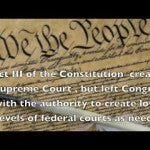
Facts About The Judiciary Act of 1789
Share
The year 2014 is the year that the Judiciary Act of 1789 celebrates its 225th anniversary. At the time of its enactment, it was considered groundbreaking. Even to this day, it is considered very innovative. It was an innovation that led to the development of a separate federal court system far removed from the individual state courts.

A look at the Judiciary Act of 1789.
image source: glogster.com
In the Constitution, Article III, Section I handles the Judicial Branch, with a certain focus on the Supreme Court. However, it must be stated that court system development was not covered within Article III. The First Congress eventually developed the Judiciary Act of 1789, leading to the establishment of the federal judiciary. This bill was signed into law by President George Washington on September 24, 1789. Through this particular act, First Congress decided that:
- The regulation of all federal courts’ jurisdiction would fall to the Congress.
- There would be specific and limited jurisdiction for the federal district courts as well as the circuit courts.
- The Supreme Court would be the one handling any appeals from federal circuit courts as well as appeals from specific cases that are heard in these state courts.
- The Supreme Court will also have access to jurisdiction originally provided for within the Constitution.
The federal judges and the Supreme Court Justices who get involved in such courts usually take oaths that they will do their duties under the United States law and under the Constitution. This is significant to judges, and many have gone to great lengths in order to uphold the law.
Over the years, there have also been changes to the Act. Congress created separate tiers of appellate circuit courts in 1891. This essentially eliminated the need for Supreme Court justices to travel in order to hear different cases in varying circuits. Such a thing is called circuit riding. However, since then, the structure of these courts has remained unchanged.
The anniversary is celebrated on the same date that the bill was signed into law, September 24. Public gatherings are likely to take place, such as the one for the District of Idaho at the State Capitol. Celebrations are to be held around the country in order to commemorate the passage and enactment of the act.
